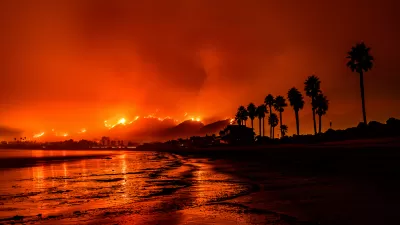Controlling fire has never been a strong suit for humans. Now, as climate change sets in, the need for better fire management is becoming dire, according to researchers.
"Balch was the lead co-author, with David Bowman, of a recent paper in Science magazine headlined "Fire in the Earth System." That ambitious paper, among other things, suggested that intentionally set fires used to peel back the world's forests for cultivation have generated a fifth of the human-generated carbon dioxide pumped into the atmosphere in the 250 years since the dawn of the Industrial Revolution.
Her work is on the burning edge, literally, of wildfire and human-caused - or anthropogenic - fires. When people meet forest, the story is ultimately predictable - expect fire."
"...So while working at different poles of wildfire research - Amazonian wildfires usually creep along at 15 meters an hour, with the flames rarely rising above knee height - both scientists see the potent interaction of people and flame.
Part of it comes from how people manage the lands under their stewardship - setting fires in the Amazon to clear more land for crops or cattle, keeping fires "tamed" in the rural-urban areas where nice homes meet stunning forest vistas, introducing everywhere non-native plants, often grasses that dry to tinder in the late summer.
But they also see something else. Changing climatic conditions, the hook in their Science paper, is creating new behavior in wildfires. It's making those Amazonian wildfires occur in an exponentially quicker cycle, and it's making areas more used to wildfires - such as Victoria state or Balch's current home in Santa Barbara, Calif. - much more inflammable."
FULL STORY: To Manage Wildfires, Manage Change First

Planetizen Federal Action Tracker
A weekly monitor of how Trump’s orders and actions are impacting planners and planning in America.

Maui's Vacation Rental Debate Turns Ugly
Verbal attacks, misinformation campaigns and fistfights plague a high-stakes debate to convert thousands of vacation rentals into long-term housing.

San Francisco Suspends Traffic Calming Amidst Record Deaths
Citing “a challenging fiscal landscape,” the city will cease the program on the heels of 42 traffic deaths, including 24 pedestrians.

Amtrak Rolls Out New Orleans to Alabama “Mardi Gras” Train
The new service will operate morning and evening departures between Mobile and New Orleans.

The Subversive Car-Free Guide to Trump's Great American Road Trip
Car-free ways to access Chicagoland’s best tourist attractions.

San Antonio and Austin are Fusing Into one Massive Megaregion
The region spanning the two central Texas cities is growing fast, posing challenges for local infrastructure and water supplies.
Urban Design for Planners 1: Software Tools
This six-course series explores essential urban design concepts using open source software and equips planners with the tools they need to participate fully in the urban design process.
Planning for Universal Design
Learn the tools for implementing Universal Design in planning regulations.
Heyer Gruel & Associates PA
JM Goldson LLC
Custer County Colorado
City of Camden Redevelopment Agency
City of Astoria
Transportation Research & Education Center (TREC) at Portland State University
Jefferson Parish Government
Camden Redevelopment Agency
City of Claremont





























